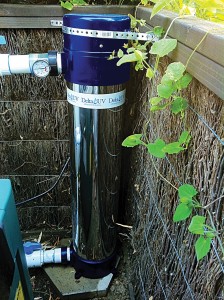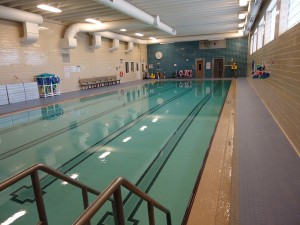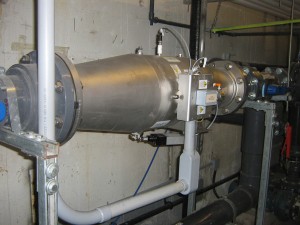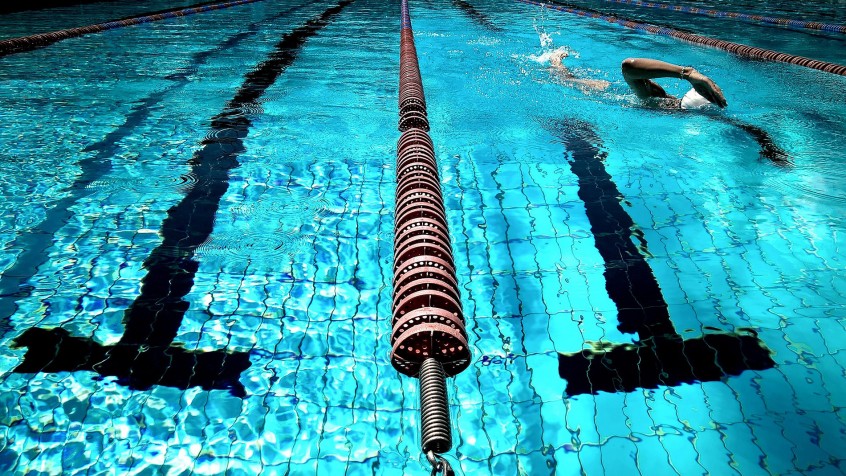Today, industry professionals face a number of questions from clients on how they can use fewer chemicals (i.e.chlorine [Cl] and/or bromine [Br]) in their pool, what alternatives are available to reduce chemical odors in and around the water, and what options do they have in cases where children may have sensitive skin and develop rashes or hives in pools using traditional sanitizing methods?
For several years, pool professionals have offered salt chlorine generators which have met many of these needs, but pool professionals are now finding ultraviolet (UV) manufacturers have improved their product designs to work on residential pools to provide additional benefits. For instance, UV sanitizers do not add anything corrosive to the water and do not require additional pH balancing acids as these systems do not alter the water’s chemistry. This makes UV sanitizers an easy, effective option for pool owners looking to reduce their chemical usage with the added bonus of reducing chloramines, unwanted smells, and skin irritations.
Getting Started

Ultraviolet (UV) systems for outdoor residential pools must be selected based on the pool’s flow rate to ensure the system properly eradicates waterborne pathogens.
Before pool professionals can start selling UV sanitizers, they need to understand their benefits and how to select the proper unit for specific aquatic applications. Not all units are the same.
It is the pool professional’s job to understand the environment in which the UV system will be installed to determine the best unit for the client’s pool. That said, it is important to match the unit size to the pool type (e.g. flow rates, commercial/residential, and indoor/outdoor) in conjunction with the pool’s bather loads.
By understanding these differences, pool professionals can easily determine which unit to recommend. The following explanations will further assist in determining what type of unit should be installed.
Low- versus medium-pressure UV systems
There are two types of UV lamps: low-pressure, high-output lamps, which emit UV rays at 254 nanometers (nm), and medium-pressure lamps that emit UV rays between 200 and 600 nm.

When dealing with an indoor residential pool, where air quality can also be a particular concern, a semi-commercial or commercial-UV unit should be considered to ensure the client gets the water and air quality improvement they desire.
Low-pressure lamps are better suited for residential applications, while medium-pressure models are designed for large commercial installations. The differences between each lamp are cost, flow requirements, and the ability to destroy chloramines (NH2Cl).
Medium-pressure lamps are commonly used in indoor pool applications as their large light spectral is more effective at reducing the health problems caused by nitrogen trichloride (i.e. chloramines), which have been linked to numerous pool closures due to poor indoor air quality (IAQ).
Pool professionals dealing with an indoor residential pool, where air quality can also be a particular concern, should consider a semi-commercial or commercial UV unit to ensure the client gets the water and air quality improvement they desire.
For outdoor residential pools, UV units must be selected based on the pool’s flow rate to ensure the system properly eradicates waterborne pathogens. When working with a semi-commercial application, e.g. a hotel, motel, or fitness facility with flow rates more than 416 litres per minute (lpm) (110 gallons per minute (gpm), a low pressure, high output UV system, or an amalgam unit designed to accommodate higher flow rates, should be considered.
Most UV system manufacturers provide tables, charts, and even mobile applications for pool professionals to determine which unit their client should purchase based on the aforementioned factors. It is important pool professionals consult manufacturer guidelines when recommending a UV system to a client.
Explaining UV and its benefits
When a client asks their pool service professional how they can reduce the amount of chemicals used in their pool, it is the perfect time to explain the benefits they would see by adding a UV sanitizer. In doing so, it is important to explain how the system works in addition to its benefits relative to other alternative sanitizer options in the marketplace.

It is important the pool owner understands ultraviolet (UV) light is a physical rather than a chemical process; therefore, there is no residual effect that is harmful to bathers, animals, plants, or the environment.
Also take the time to explain how the system can be easily installed (added) onto their pool’s existing circulation system. When doing this, use manufacturer diagrams and brochures to illustrate the process, showing how the pool water passes through the light chamber in the unit, exposing it to a high intensity, germicidal UV ray that destroys waterborne pathogens, including algae, bacteria, and cyst, as well as viruses such as E.Coli,Cryptosporidium (Crypto), and Giardia.
It is important the pool owner understands UV is a physical rather than a chemical process, which is what makes these sanitization systems environmentally friendly. There is no residual effect that is harmful to bathers, animals, plants, or the environment. The result is clean water that looks, feels, and smells better.
Answering common questions from clients
How soon will the water quality improve?
This is a valid question and one in which the service professional can guarantee that a pool owner will see improvement in the water and surrounding air within one to three days after the UV system has been installed. Once the entire volume of pool water has circulated through the unit, the UV rays will not only sanitize the water, but also reduce or eliminate the chloramines which are normally present as a result of chlorine combining with nitrogen-ammonia compounds.
How does UV improve air quality?
At a molecular level, UV light destroys the formation of chloramines before they reach the air through evaporation.
Will the use of chlorine or bromine be reduced when a UV system is installed?
Yes. UV light will eradicate all pathogens passing through the unit, thus making the smaller amount of chemical residuals much more effective. Therefore, savings between 50 and 85 percent can be expected due to reduced chlorine/bromine consumption. Further, the addition of a UV system creates a pool water environment that is as close to ‘chemical-free’ as possible. Most importantly, UV technology helps avoid the need for other chemicals such as non-chlorine shock treatment, which makes pool water unsafe until after a designated time period.
Is there any residual chemical effect from UV?
No. UV light is used to destroy bacteria and micro-organisms and is applied only to the pool water passing through the unit’s internal light chamber. No chemicals are added to the pool via the UV system.
Can a UV system be installed on a pool equipped with a salt chlorine generator?
This is one of the most common questions pool professionals face. The short answer is yes. UV systems can be used on saltwater pools; however, the level of chlorine production by the electrolytic generator should be reduced to provide the minimum amount of chlorine residual.
Further, as UV is not corrosive, the ability to reduce salt and chlorine levels is beneficial for bathers as well as the pool’s equipment.
What maintenance is required on a UV system?
The only maintenance required is an annual cleaning of the quartz tube inside the UV unit and replacement of the UV lamp when it reaches the end of its life. This procedure typically takes five to 10 minutes to complete and can be easily accomplished using a screwdriver and crescent wrench.
Installation procedures
 As mentioned earlier, UV systems can be easily added to the pool’s existing circulation system, after the filter and before other accessories such as heaters or chlorinators. It should be plumbed in at the bottom inlet so the UV system properly fills with water in relation to the unit’s flow rating. Units come with tailpieces that plumb into the pipes completing the circulation system with the UV sanitizer by using a few elbows and valves to bypass the unit.
As mentioned earlier, UV systems can be easily added to the pool’s existing circulation system, after the filter and before other accessories such as heaters or chlorinators. It should be plumbed in at the bottom inlet so the UV system properly fills with water in relation to the unit’s flow rating. Units come with tailpieces that plumb into the pipes completing the circulation system with the UV sanitizer by using a few elbows and valves to bypass the unit.

The differences between a low-pressure ultraviolet (UV) system (residential pools) and a medium-pressure unit (commercial pools) are lamp cost, flow requirements, and the ability to destroy chloramines.
The system will likely take up a 254-mm (10-in.) footprint on the equipment pad; therefore, it is important to ensure there is enough space to remove the lamp straight out of the UV system as the glass lamp or quartz tubes cannot be bent. The system’s ballasts are plugged in or hard-wired to the filtration control in either 110/220 volt so the UV system operates in conjunction with the pump turning on/off.
The idea of plumbing in a bypass is to make servicing/maintenance (e.g. winterizing) easier by separating the UV system when necessary. As the UV lamp and quartz tube are made of glass, they need to be brought inside to avoid winter damage (i.e. freezing) when the pool is not being used.
A few last words
It is important to know, like any equipment, not all UV systems are created equal. Therefore, retailers should check the following:
- Are the UV systems truly environmentally friendly?
- Are the units energy efficient?
- Can the unit selected for the job accommodate the pool’s flow rate? Every reliable UV system is designed to handle a maximum flow rate.
Retailers should also check with the manufacturer about each system’s certifications. Pool professionals installing a UV system on a commercial pool can consult the NSF International website for a list of approved UV water treatment units for commercial applications.
UV systems provide an excellent upsell opportunity for pool professionals and offer many benefits to the consumer. Not only will customers be pleased with their improved water and air quality, but retailers will also have another product that helps make pool maintenance easier for their customers.
This article was written by Jeff Boynton and originally appeared on Pool & Spa Marketing [link].
